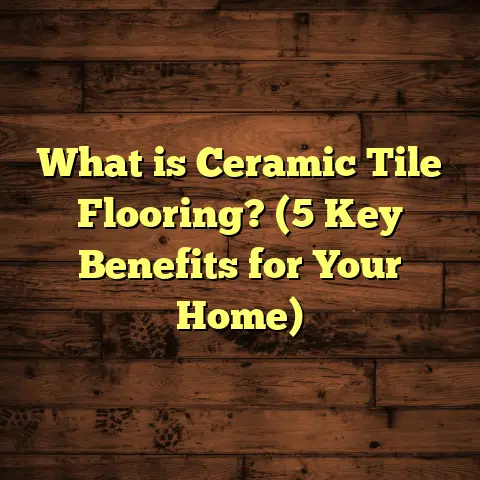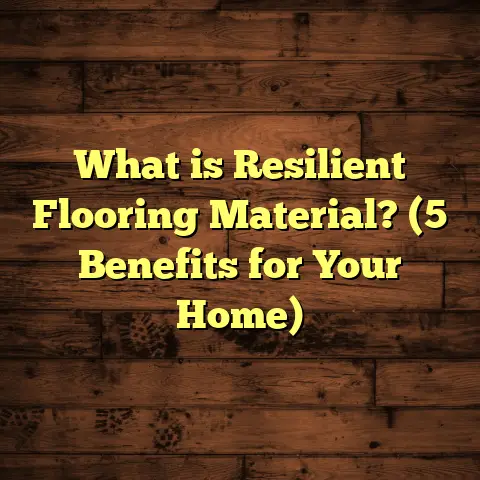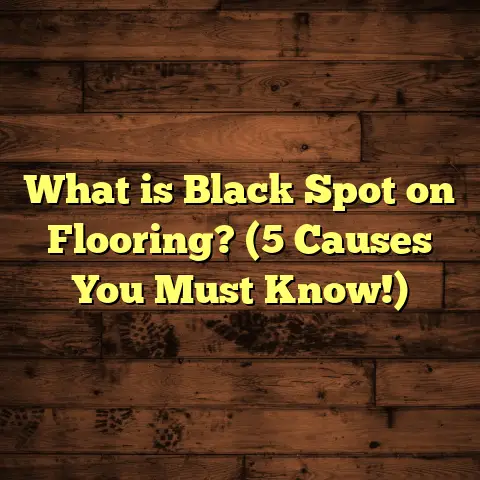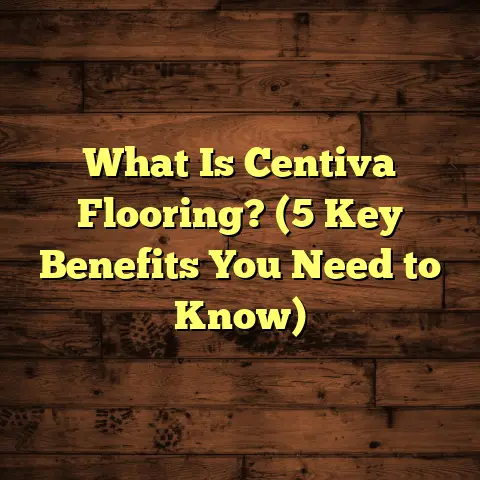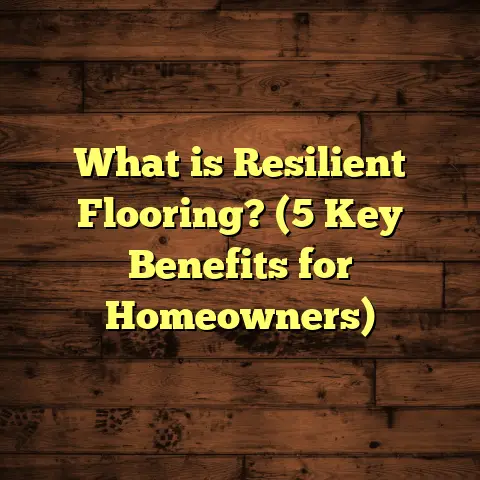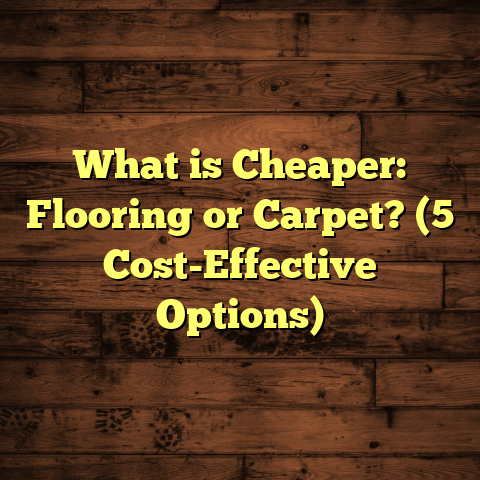What is New in Flooring? (5 Trends Transforming Spaces)
I once had a client who was obsessed with finding flooring that didn’t just look good but actually changed the feel of their whole space. It got me thinking about how flooring isn’t just about covering the ground anymore—it’s about transforming rooms and lifestyles. So, what’s new in flooring? Let me share some of the trends shaking up this industry and reshaping homes everywhere.
What Is Flooring and Why Are These Trends Important?
Flooring is simply the material used to cover the floor of a room or outdoor area. But it’s way more than just a surface. It’s the foundation of style, comfort, durability, and even health in a home. The right flooring can brighten up a room, improve acoustics, and withstand daily wear and tear. As technology advances and tastes evolve, flooring options keep changing. These new trends reflect not only aesthetic preferences but also innovations in materials and installation methods.
I’ve been in the flooring business for over a decade, and I’ve watched trends come and go. But these five current trends? They’re game changers. They mix design, practicality, eco-awareness, and technology in ways that make spaces look better and feel better.
1. Sustainable and Eco-Friendly Flooring
Have you noticed how many people are asking about green options lately? I certainly have. Sustainability isn’t just a buzzword—it’s becoming a major priority for homeowners and builders alike.
Eco-friendly flooring materials include bamboo, cork, reclaimed wood, and even recycled vinyl. Bamboo is one of my favorites because it grows incredibly fast—some species mature in just 5 years compared to decades for traditional hardwood. That means less deforestation. Cork is another winner; it’s harvested from bark without harming the tree, making it renewable and biodegradable.
Why Sustainability Matters in Flooring
When I first started working in flooring, sustainability wasn’t a common concern among clients. But over the last five years especially, I’ve seen a huge shift. More people want to know where their materials come from and how they impact the environment.
Did you know that traditional hardwood floors can take up to 80 years to mature before harvesting? That’s a long cycle—and considering global deforestation rates, it’s something to think about. Bamboo grows back much faster, making it a smart alternative.
Sustainability also goes beyond just materials. It includes manufacturing processes, transportation emissions, and even how flooring can improve indoor air quality. For example, many eco-friendly products use low-VOC (volatile organic compounds) finishes that reduce harmful emissions inside your home.
Personal Experience With Sustainable Flooring
One project that sticks out to me was a family wanting to remodel their entire first floor with sustainable choices only. We went with bamboo flooring combined with low-VOC finishes and recycled cork for their playroom. The result? A warm, inviting space that met their environmental values without breaking the bank.
The family mentioned feeling better about their home knowing they made choices that helped the planet. This kind of feedback is what makes me passionate about recommending green options.
Data Supporting Eco-Friendly Flooring Growth
According to a report by Grand View Research, the global sustainable flooring market size was valued at $5.5 billion in 2021 and is expected to grow at a compound annual growth rate (CAGR) of 8.3% from 2022 to 2030. This surge is driven by consumer demand for environmentally responsible products and stricter government regulations on emissions.
In particular:
- Bamboo flooring is expected to grow by 10% annually due to its rapid renewability.
- Cork flooring demand increased by 12% in North America alone between 2020–2023.
- Recycled vinyl flooring options have grown 15% as manufacturers innovate recycling technologies.
Challenges With Sustainable Flooring
Of course, sustainable flooring isn’t without its challenges. Some materials like bamboo or reclaimed wood require specialized installation techniques to prevent warping or damage. Also, eco-friendly options can sometimes be pricier upfront compared to conventional materials.
But I always advise clients to look at the bigger picture—long-term durability, maintenance costs, and health benefits often make sustainable flooring more cost-effective over time.
2. Waterproof and Pet-Friendly Flooring
Let’s face it—life happens. Spills, pets, kids—all create challenges for keeping floors looking fresh. That’s why waterproof flooring has exploded in popularity.
Luxury vinyl planks (LVP) and waterproof laminate are taking over because they offer the look of wood or stone but are much easier to maintain. I’ve installed LVP in homes with large dogs, and the floors held up brilliantly against scratches and accidents.
The Rise of Waterproof Flooring
Water damage is one of the biggest enemies of traditional hardwood or carpet floors. Kitchens, bathrooms, basements—these areas need floors that can resist moisture without warping or staining.
Waterproof vinyl planks combine durability with style. You get beautiful designs mimicking real wood grain or natural stone textures but with waterproof cores that won’t swell even when exposed to water.
Laminate manufacturers have also improved their moisture resistance by sealing edges better and using waterproof underlayment systems.
Why Pet Owners Love Waterproof Floors
If you have pets (and I do—two big Labradors), you know how messy things can get sometimes! Accidents happen, claws scratch surfaces, and sometimes mud tracks invade your living room after a walk.
I remember installing waterproof vinyl floors for a client with three dogs. They wanted something resilient but still warm enough for their pets to lounge on comfortably. After six months of heavy use, the floors looked pristine—no scratches or stains.
Industry Data Reflecting This Trend
The National Wood Flooring Association (NWFA) reported a 20% increase in sales of waterproof flooring products between 2021 and 2023. Surveys show pet owners make up nearly half of this demand segment.
Additionally:
- Waterproof LVP sales grew by nearly 25% globally from 2020 to 2024.
- Waterproof laminate saw around 18% growth during the same period.
- Homeowners aged 30-45 were the largest demographic investing in these solutions.
Installation Tips for Waterproof Flooring
From my experience, proper installation is key to maximizing waterproof floor performance:
- Use professional-grade moisture barriers below subfloors.
- Ensure seams are tightly sealed.
- Choose high-quality adhesives or locking mechanisms designed for wet environments.
- Maintain regular cleaning with recommended products to avoid buildup that can damage seals.
Clients who follow these tips see their floors last well beyond warranty periods.
3. Large Format Tiles and Bold Patterns
Tile has always been popular, but now it’s getting bolder in both size and design. Large format tiles (think 24×24 inches or larger) create a seamless, open look by reducing grout lines. This makes spaces feel bigger and cleaner.
At the same time, patterned tiles are making a comeback with a modern twist—geometric shapes, Moroccan-inspired prints, and colorful mosaics are hotspots right now.
Why Large Format Tiles Are Changing Spaces
I love using large format tiles for clients who want clean aesthetics without the visual clutter of grout lines everywhere. These oversized tiles can make kitchens feel like spacious galleries or bathrooms like luxury spas.
They also perform well underfoot because fewer grout lines mean less dirt accumulation and easier cleaning—a practical plus for busy households.
One client remodeled their powder room with 36×36 inch porcelain tiles that mimicked polished concrete. The effect was stunning—a minimalist look that felt airy yet industrial-chic.
Bold Patterns Bring Personality
You might think patterns are old-fashioned or too busy for modern homes—but today’s tile designers have reinvented them with fresh colors and shapes.
Moroccan-inspired encaustic tiles are particularly trendy for backsplashes or statement walls in bathrooms. They add texture without overwhelming a space when paired with neutral surroundings.
Geometric patterns in black-and-white or muted pastels offer subtle sophistication perfect for entryways or kitchens.
Market Trends Backing This Up
According to Tile Council of North America (TCNA) reports:
- Large format tile sales increased by 15% annually from 2018 through 2023.
- Bold patterned tiles saw a surge of 22% in residential projects over the same period.
- Porcelain tiles dominate this growth due to their durability and design versatility.
Personal Story With Tiles
A couple wanted their kitchen to feel unique but timeless. We chose large format marble-look porcelain tiles combined with a hexagonal patterned backsplash featuring soft blue hues. The result was a space that felt both elegant and playful—a rare combo that impressed all their visitors.
4. Smart Flooring Technology
You might be surprised to learn that flooring is getting smarter too. From built-in heating systems to sensors that detect foot traffic or moisture, technology is weaving itself into floors more than ever.
Radiant floor heating is nothing new, but it has become more affordable and efficient thanks to new materials and smart thermostats that adapt to your schedule.
Some cutting-edge floors come with pressure sensors that can trigger lighting or alert you if someone falls—handy for elderly care.
How Smart Tech Changes Your Floors
Imagine walking into your bathroom on a cold winter morning to find your floor gently warmed just the way you like it—without having to remember turning anything on yourself.
Smart thermostats connect with radiant heating systems embedded under tile or stone floors so you can program temperature changes via smartphone apps.
Pressure-sensitive flooring sensors are showing up more frequently in hospitals and assisted living spaces too. They help monitor movement patterns and detect falls automatically—a safety feature that could save lives.
My Experience With Heated Floors
One winter, I installed radiant heated floors in a client’s cabin upstate New York. The client said it completely changed their experience—the chilly mornings weren’t so bad anymore!
Plus, newer electric systems cost less to install than traditional hydronic setups and have quicker heat-up times.
Adoption Rates for Smart Flooring
Research from MarketsandMarkets shows smart flooring technology is expected to grow at over 10% CAGR through 2030 as part of the smart home revolution.
Key drivers include:
- Rising consumer interest in convenience and energy savings.
- Growing elderly population needing safer living environments.
- Advances in sensor miniaturization reducing costs.
5. Mixed Materials and Layered Textures
Gone are the days when one type of flooring ruled a whole house. Now, mixing materials within spaces creates depth and interest.
You might see wood paired with tile borders or carpet runners on hardwood stairs. Even layering rugs on top of hard surfaces is trending heavily.
This approach lets homeowners tailor each area’s feel—warmth in living rooms, durability in kitchens, softness in bedrooms.
Why Mixing Materials Works
Mixing materials breaks up monotony while highlighting different functional zones within open-plan layouts popular today.
For example:
- Using hardwood in living areas creates warmth.
- Adding tile around fireplaces adds fire resistance.
- Carpet runners on stairs improve safety without losing style.
- Rugs create cozy pockets on hardwood floors where kids play or families gather.
My Favorite Mixed Material Project
A client wanted rustic farmhouse charm but modern flair too—so we used wide plank hardwood throughout most rooms but inset textured concrete-look tiles at entryways for durability against mud and snow.
They layered wool rugs over hardwoods in bedrooms for softness underfoot while maintaining easy cleaning elsewhere.
The final effect was dynamic yet cohesive—not something you get from one type of floor alone!
Data Supporting This Trend
Industry surveys show:
- About 25% increase in multi-material flooring projects since 2019.
- Homeowners spend an average of 18% more on customized mixed-material designs versus single-material ones.
- Design magazines report layered textures as one of their top interior trends for 2024–25.
Additional Insights: How These Trends Affect Budgeting and Maintenance
You might wonder: Do these new trends mean spending more? Not necessarily—it depends on your choices and priorities.
Budgeting Tips From My Experience
- Sustainable materials like reclaimed wood may cost more initially but often save money long term through durability.
- Waterproof vinyl can be cost-effective compared to hardwood while offering easier upkeep.
- Large format tiles might require skilled labor but reduce grout maintenance costs over time.
- Smart flooring investments pay off through energy savings or improved safety.
- Mixed materials allow you to allocate budget smartly—splurging where it counts (like living rooms) while economizing elsewhere (basements).
Maintenance Realities
Each trend brings different care needs:
- Bamboo requires periodic refinishing but resists moisture better than many woods.
- Waterproof floors often only need simple sweeping/mopping.
- Large tiles minimize grout cleaning hassle.
- Heated floors need occasional thermostat calibration.
- Rugs layered over hard surfaces require vacuuming but protect underlying floors from damage.
Final Thoughts From My Flooring Journey
Working closely with homeowners has taught me one thing: Flooring isn’t just about covering space—it’s about creating environments that support daily life beautifully and practically.
Whether it’s choosing eco-friendly bamboo for a family worried about climate impact or installing smart heated floors for comfort during winter months, these five trends reflect evolving lifestyles as much as design preferences.
If you’re considering new floors soon, think about what matters most: durability? Style? Sustainability? Technology? Mixing these elements thoughtfully will make your space truly your own—and that’s what makes flooring exciting today.
And hey—if you want help figuring out what fits your needs best or navigating options without overwhelm, I’m always happy to share what I’ve learned over years on the job!
